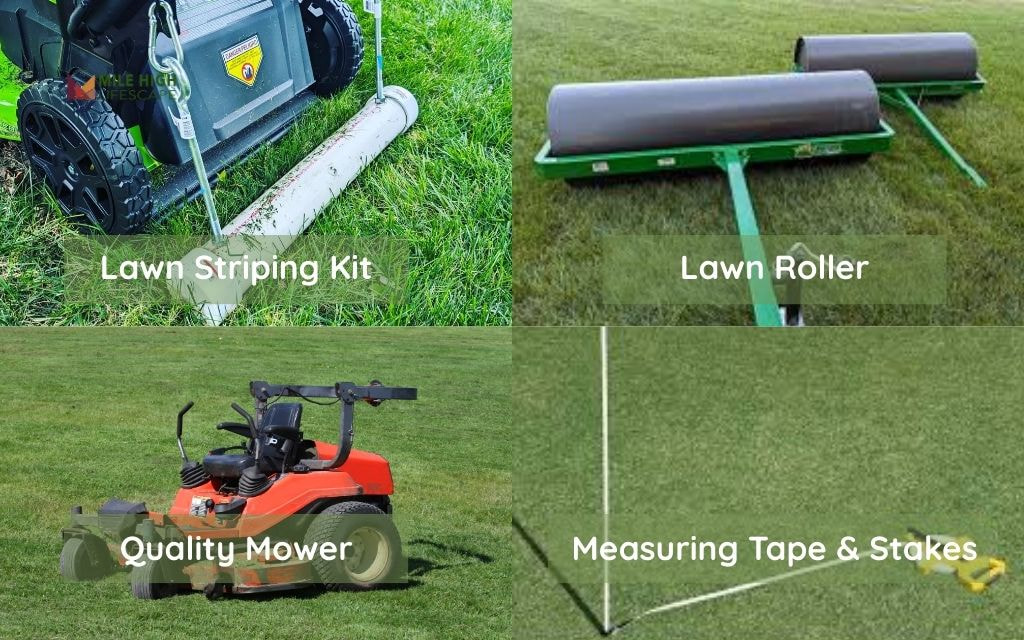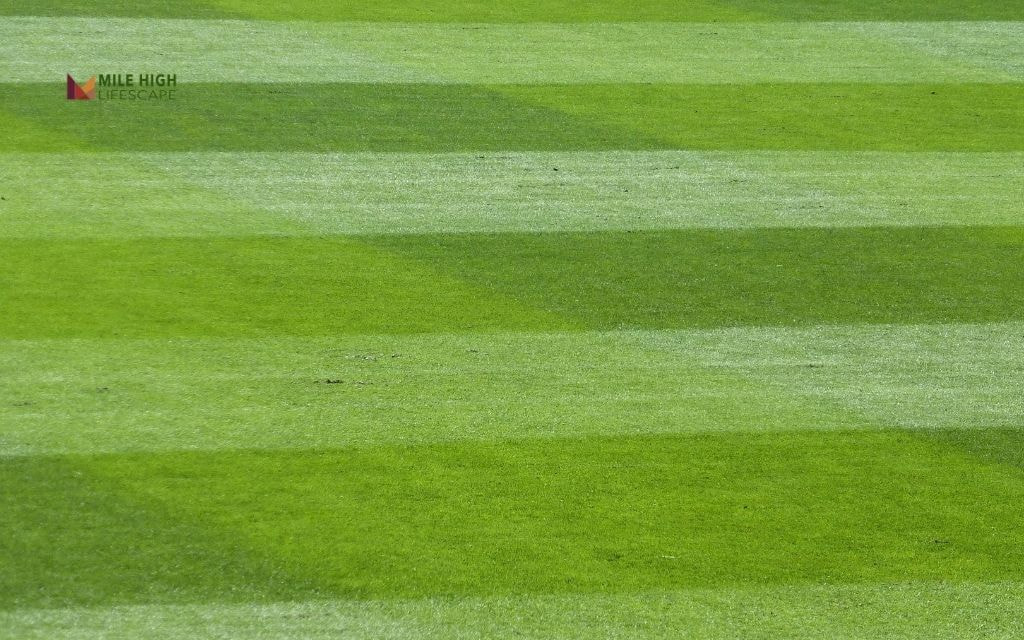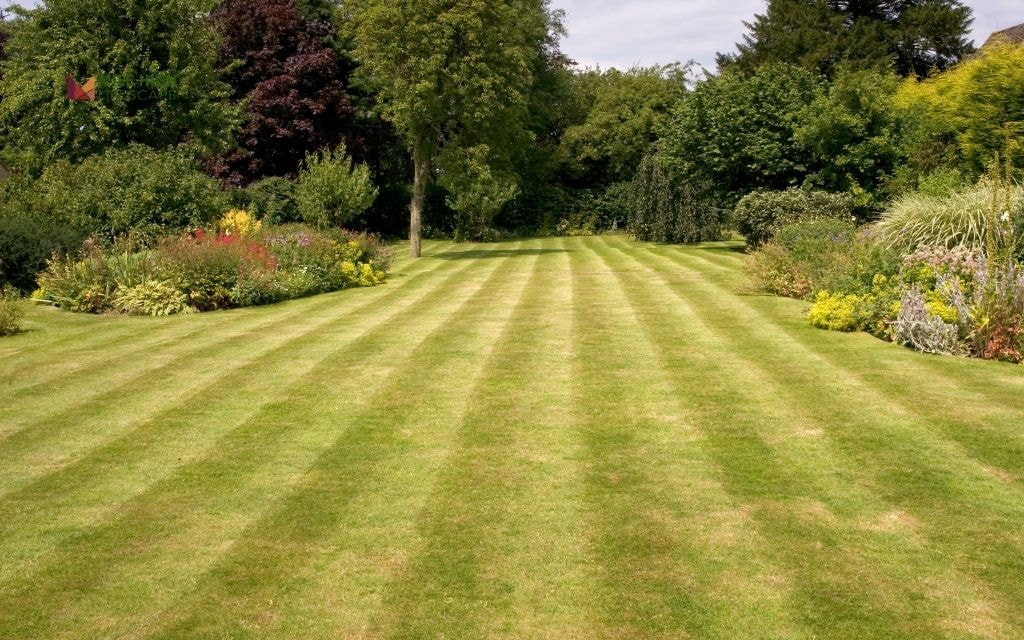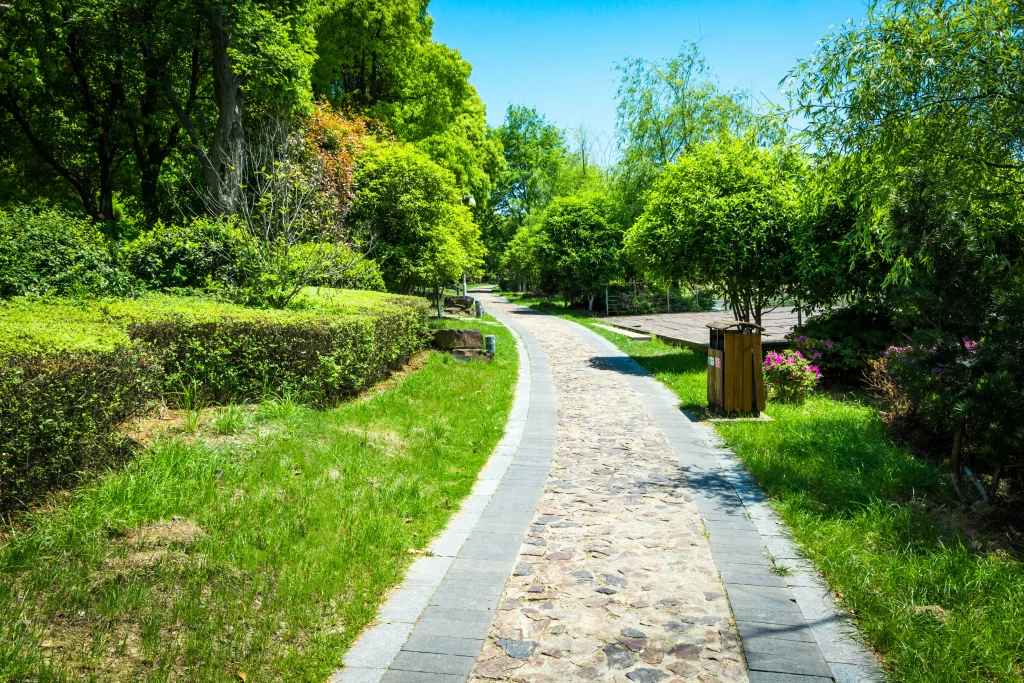A beautifully striped lawn isn’t just for professional sports fields and golf courses – it can be the crown jewel of your Denver home’s landscape too.
Those alternating light and dark green bands create a visual masterpiece that elevates your property’s curb appeal and makes your outdoor space look meticulously maintained.
In this comprehensive guide, we’ll walk you through everything you need to know about achieving professional-quality lawn stripes in Denver’s semi-arid climate.
From the science behind those perfect patterns to the specific tools, grass types, and maintenance routines that work best in our region, you’ll discover how to maintain this striking look throughout Colorado’s distinctive seasons.
Why Do Stripes Appear on Lawns?
The science behind lawn striping is simpler than you might think – it’s all about light, reflection, and the way grass bends. When you understand these basic principles, you’ll be able to create crisp, defined patterns that transform your Denver lawn into a showpiece.
- Stripes appear due to grass blades bending in different directions. The direction of the bend determines whether the grass appears lighter or darker from your viewing angle.
- The contrast in light reflection creates the visual stripe pattern. Denver’s abundant sunshine creates ideal conditions for dramatic lawn striping effects.
- Mowing direction and roller tools are key to achieving clean, sharp stripes. The weight of a roller bends grass more effectively and creates more defined, longer-lasting patterns.
Tools You’ll Need For Your Striped Lawn
Creating a perfectly striped lawn requires more than just a standard mower. The right equipment makes a significant difference in the quality and longevity of your stripes, especially in Denver’s unique growing conditions.
Here’s what you’ll need to achieve professional-looking results:
Lawn Striping Kit
These attachable devices add weight behind your mower to bend grass blades more effectively. They typically consist of a cylindrical roller that attaches to the back of your mower. For Denver lawns, look for adjustable models that can be adapted to different grass heights throughout our seasonal changes.
Lawn Roller
A dedicated lawn roller provides more weight and better control for creating crisp, well-defined stripes. These can be water or sand-filled to adjust the weight based on your grass type. In Denver’s sometimes dry conditions, a properly weighted roller helps ensure grass bends without causing damage.
Quality Mower
While any mower can create some striping effect, reel mowers often produce the most professional results because they cut grass more cleanly and precisely. For rotary mowers, look for models with adjustable height settings and the ability to attach striping kits.
Measuring Tape & Stakes
For perfectly straight lines and complex patterns, measuring tools help ensure precision. In Denver’s often rectangular yards, these tools are essential for creating symmetrical patterns that enhance your property’s architectural lines.

Step-by-Step Guide: How to Stripe Your Lawn in Denver
Creating perfect lawn stripes requires attention to detail and an understanding of Denver’s unique climate conditions.
Follow this step-by-step guide to achieve professional-quality striped lawn that will withstand our intense sun, occasional drought conditions, and seasonal changes.
Step 1: Prepare Your Lawn
Before striping, mow your lawn at the optimal height for Denver’s climate – typically 2.5 to 3.5 inches for cool-season grasses.
This height range helps grass withstand our dry conditions while still allowing for effective bending. Remove any debris, sticks, or rocks that could interfere with the mowing pattern or damage your equipment.
Step 2: Attach Your Striping Kit or Roller
Secure your striping kit to your mower according to the manufacturer’s instructions. For Denver lawns, especially in drier months, adjust the weight of your roller to be effective without stressing the grass. The ideal setup should bend the grass without flattening it against the soil.
Step 3: Plan Your Pattern
For a basic stripe pattern, choose whether you want horizontal, vertical, or diagonal stripes. For Denver yards with mountain views, consider patterns that complement your landscape perspective. Start with a straight edge like a driveway or sidewalk as your guide for the first stripe.
Step 4: Mow Your First Strip
Move in a straight line from one end of your lawn to the other. For the most defined stripes in Denver’s bright sunlight, mow parallel to your viewing area (often the street or your patio) so the striping effect is most visible.
Step 5: Turn Around and Mow in the Opposite Direction
Once you reach the end of your lawn, turn around and mow in the opposite direction, parallel to your first strip. This creates the contrasting light and dark pattern. For Denver’s often rectangular lots, consistent turn patterns help maintain even stripe width.
Step 6: Continue the Pattern
Repeat this alternating pattern across your entire lawn. For the most professional look, overlap each pass slightly (about 1-2 inches) to prevent unmowed strips. In Denver’s sometimes uneven terrain, pay special attention to maintaining consistent lines on slopes.
Step 7: Edge and Trim
Complete the professional look by trimming along sidewalks, driveways, and garden beds. Clean edges frame your striping pattern and enhance the overall aesthetic. In Denver’s dry climate, this also creates firebreaks between your lush lawn and other landscape elements.

Denver-Specific Striping Considerations
- Mow during cooler parts of the day (morning or evening) to reduce stress on your grass, especially during our hot summer months.
- Adjust your mowing height seasonally—slightly higher in summer (3-3.5 inches) to protect roots from heat and slightly lower in spring and fall (2.5-3 inches).
- Consider north-south stripe patterns during summer to minimize sun exposure on freshly cut grass edges.
- Water deeply the day before striping to help grass blades bend more effectively without breaking.
Best Grass Types for Creating Stripes in Denver
Not all grasses respond equally to striping techniques. In Denver’s unique climate – characterized by low humidity, intense sun, and significant temperature fluctuations – choosing the right grass variety is crucial for achieving and maintaining those picture-perfect striped lawn throughout the year.
- Kentucky Bluegrass: The gold standard for lawn striping in Denver, Kentucky Bluegrass creates dramatic stripes thanks to its medium to fine texture and deep green color that highlights light differences.
- Tall Fescue: Increasingly popular in Denver due to its drought tolerance, tall fescue produces good striping results while requiring less water than bluegrass. Its broader blades provide noticeable light reflection differences.
- Perennial Ryegrass: Known for its quick establishment and shiny leaf surface, ryegrass can create dramatic striping effects. Its rapid growth makes it ideal for quickly establishing a stripable lawn in Denver’s short growing season.
- Fine Fescue: Excellent for partially shaded Denver yards, fine fescue has slender blades that bend easily for striping. Its drought tolerance makes it well-suited for our water-conscious region.
Pro Tip: For the best combination of striping quality and Denver climate adaptation, we recommend a blend of 60% Kentucky Bluegrass, 20% Perennial Ryegrass, and 20% Tall Fescue. This mixture provides excellent striping capability while offering improved drought tolerance and disease resistance for Denver’s unique growing conditions.
How Often Should You Stripe Your Lawn?
Maintaining a beautifully striped lawn requires the right balance of regular care without overdoing it.
In Denver’s climate, with our distinct seasonal changes, striping frequency needs to be adjusted throughout the year for the best results and healthiest grass.
Seasonal Striping Schedule for Denver
- Spring (April-May): Every 5-7 days as growth accelerates with our spring moisture. Change direction with each mowing to prevent ruts and encourage upright growth.
- Summer (June-August): Every 7-10 days during peak heat. Mow when temperatures are cooler and raise height slightly to reduce stress on grass. Alternate patterns every other mowing.
- Fall (September-October): Every 7-14 days as growth slows. This is an ideal time for creating more intricate patterns as cooler weather provides optimal growing conditions.
- Winter (November-March): Minimal to none during dormancy periods. If mowing is needed on warmer days, keep striping light to avoid damage to semi-dormant grass.
Important Striping Frequency Considerations
- Follow the one-third rule: Never remove more than one-third of the grass blade height in a single mowing. This is especially important in Denver where grass can experience stress from our intense sun and dry conditions.
- Alternate directions: Change your striping pattern at least monthly to prevent grass from developing a permanent lean and to reduce soil compaction in wheel tracks.
- Consider growth rate: During peak growing seasons with adequate irrigation, Denver lawns may need more frequent striping. During drought or water restrictions, reduce frequency.
- Special occasions: Consider refreshing your stripes before hosting outdoor events or when you want your property to look its best for holidays or special occasions.
Pro Tip: During July-August dry spells, consider watering more deeply but less frequently, and stripe your lawn early in the morning when grass blades are still moist with dew. This creates crisper lines while reducing stress on the grass.

Denver-Specific Tips for Striping Your Lawn
Denver’s unique climate presents both challenges and opportunities for lawn striping. Our high altitude, intense sunlight, low humidity, and clay-heavy soils require specific approaches to achieve and maintain professional-quality striped lawns throughout the year.
- Water deeply but infrequently in the early morning hours (4-7 AM) to minimize evaporation and promote deeper root growth. This timing allows moisture to penetrate before the day’s heat intensifies.
- Mow only when grass is completely dry to prevent clumping and uneven cuts that disrupt stripe patterns. Denver’s low humidity typically means morning dew dries quickly, but irrigation timing should account for this requirement.
- Implement regular aeration in spring and fall to combat our region’s clay-heavy soils. This practice improves water absorption and reduces soil compaction, creating healthier grass that responds better to striping techniques.
- Adjust your mowing height seasonally – taller in summer (3-4 inches) and slightly shorter in spring and fall (2.5-3 inches). Taller grass bends more dramatically, creating more pronounced stripes during our intense summer months.
Common Mistakes to Avoid When Striping Your Lawn
Even experienced homeowners make these common striping mistakes that compromise results:
- Cutting too short: Scalping your lawn prevents proper blade bending and stresses the grass. Denver’s altitude and intense sun exposure magnify this stress, making proper height maintenance crucial.
- Using dull blades: Dull mower blades tear grass rather than cut cleanly, causing jagged edges that don’t reflect light properly and can introduce disease. Sharpen blades at least twice per season.
- Inconsistent mowing patterns: Varying your route randomly destroys established stripes. Develop a consistent pattern and maintain it throughout the season for best results.
- Neglecting roller pressure: Most homeowners don’t add sufficient weight to their striping kit. The roller needs appropriate pressure to bend grass effectively, especially in Denver’s typically dense soil conditions.
- Mowing wet grass: This causes clumping, uneven cuts, and potential lawn damage. Denver’s occasional summer thunderstorms require patience – wait until the lawn dries completely before striping.
- Forgetting seasonal adjustments: Failing to adapt techniques to Denver’s distinct seasons results in poor striping during winter dormancy and summer stress periods.

When to Call a Professional for Lawn Striping
While DIY striping can be rewarding, there are situations when calling a professional lawn care service like Mile High Lifescape makes sense:
- Complex or large properties with multiple elevations or specialized areas that require expert handling
- Special occasions when you want truly professional results for events, home sales, or photography
- Intricate patterns beyond basic stripes, such as waves, circles, or logo designs
- Lawn rehabilitation when combining striping with other treatments like aeration, overseeding, or soil amendment
- Seasonal maintenance packages that include regular professional striping on a schedule
At Mile High Lifescape, our professional lawn striping services include commercial-grade equipment that creates more defined, longer-lasting stripes than typically possible with residential equipment.
Our technicians are specially trained in Denver-specific lawn care practices that ensure your grass remains healthy while looking its best.
Conclusion
Creating and maintaining a beautifully striped lawn in Denver is both an art and a science. The distinctive climate of Denver presents unique challenges, but with the right techniques, tools, and grass varieties, you can achieve professional-quality stripes that enhance your property’s curb appeal throughout most of the year.
Remember that successful lawn striping in Denver requires attention to our region’s specific conditions – adapting your approach to our intense sunlight, lower humidity, clay soils, and seasonal changes.
By following the recommendations in this guide and avoiding common mistakes, you’ll be well on your way to creating eye-catching lawn stripes that will make your property stand out in your neighborhood.
Whether you choose to create your own lawn stripes or enlist professional help from Mile High Lifescape, the effort invested in proper lawn striping techniques pays dividends not just in appearance but in the overall health and resilience of your lawn.
Frequently Asked Questions (FAQs)
What causes stripes on the lawn?
Lawn stripes are created when grass blades bend in different directions, causing light to reflect differently. When grass bends toward you, it appears darker; when it bends away, it appears lighter. This light reflection creates the visible striping effect. Rollers or striping kits attached to mowers enhance this effect by bending grass more dramatically in consistent patterns.
How long do lawn stripes last in Denver’s climate?
In Denver’s climate, lawn stripes typically last 4-7 days during the growing season, depending on weather conditions, grass type, and how dramatically the grass was bent during striping.
Is lawn striping bad for my grass?
When done properly, lawn striping is not harmful to grass. However, consistently mowing in the same pattern can cause grass to permanently lean in one direction and create soil compaction in wheel tracks. Well-executed striping can actually promote even growth, water distribution, and easier identification of lawn problems.
Does wet grass stripe better?
Slightly damp grass often creates better stripes as the moisture adds weight to grass blades, helping them bend more easily and stay in position longer. However, avoid mowing when grass is very wet, as this can lead to clumping, uneven cuts, and potential lawn damage. For best results in our region, water deeply the day before you plan to stripe, then mow when the grass surface is dry but soil moisture is still adequate.
How do I fix lawn stripes that won’t go away?
If grass has developed a permanent lean from consistent striping in the same direction, correct it by vigorously raking the affected areas to stand the grass upright again. Then mow in the opposite direction with a roller or striping kit. In extreme cases, you may need to overseed affected areas.
